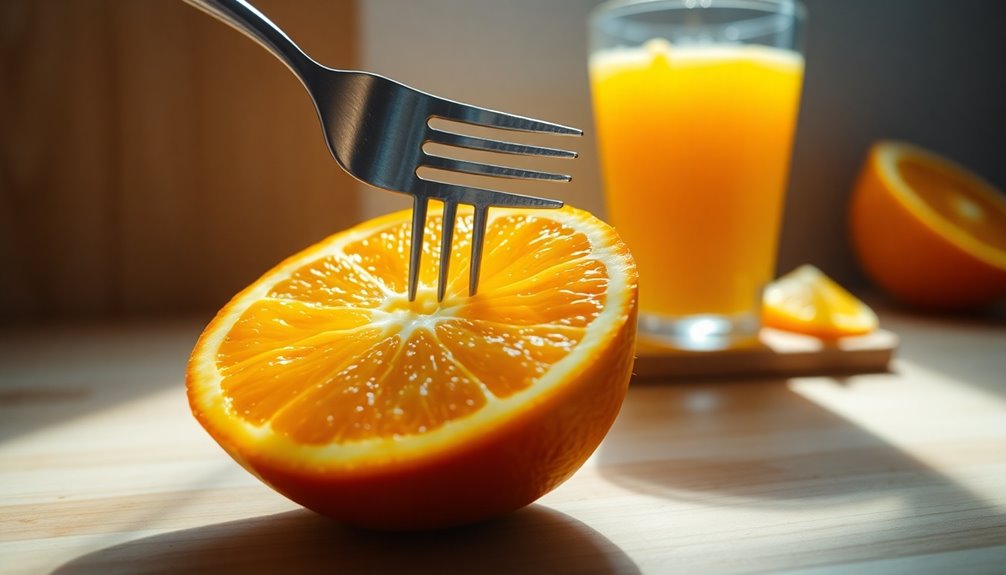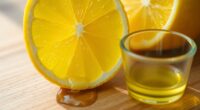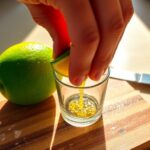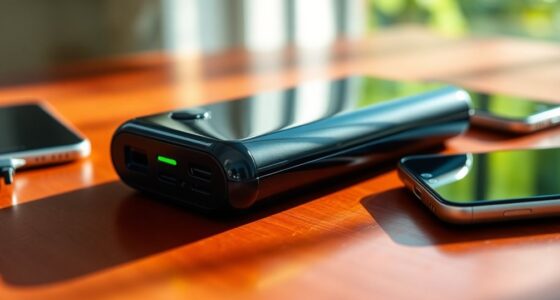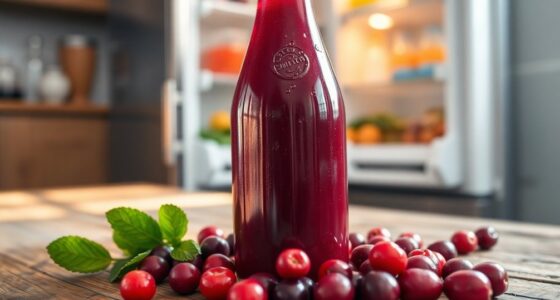To juice an orange without a juicer, start by selecting fresh, ripe oranges. Cut each one in half horizontally, removing any seeds. Hold a half over a bowl and apply firm pressure with your hands to extract the juice. You can use a fork to press against the pulp for even more juice. Strain the juice through a strainer for a smoother texture, and you'll have fresh orange juice to enjoy. There's more to perfecting your citrus skills!
Key Takeaways
- Select fresh, ripe oranges that yield slightly when squeezed and are free from blemishes for optimal juicing.
- Cut each orange in half horizontally with a sharp knife, exposing the juice-filled segments.
- Squeeze each orange half firmly over a bowl or glass to extract juice, using a fork to press for more if needed.
- Strain the juice through a strainer or nut milk bag to achieve a smoother texture, removing pulp and seeds.
- Consume the juice immediately for maximum health benefits, or store in an airtight container in the refrigerator for up to three days.
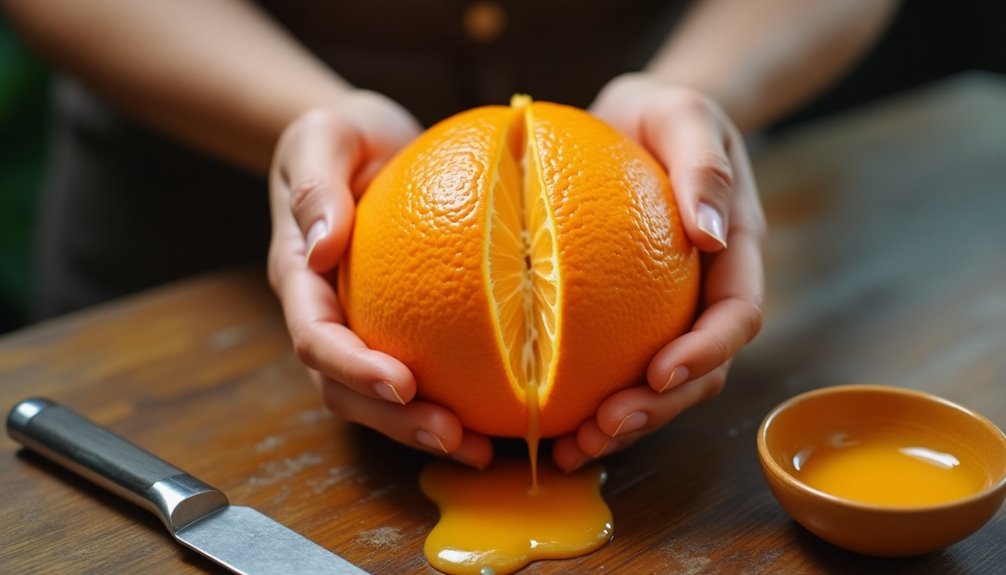
Juicing an orange without a juicer is easier than you might think. You don't need fancy equipment to enjoy fresh, delicious orange juice. All you need are some ripe oranges and a few simple tools you probably already have at home.
Start by selecting fresh oranges that yield slightly when you squeeze them, as this indicates juiciness. The best oranges for juicing are usually those that feel heavy for their size and have a slightly soft skin.
Once you've got your fresh oranges, grab a sharp knife and cut each orange in half horizontally. This exposes the juice-filled segments that are just waiting to be squeezed. It's also a good idea to check for any seeds and remove them before you start juicing. You don't want those pesky seeds making their way into your drink!
Now, it's time to squeeze the juice. Hold one orange half over a bowl or glass and apply firm pressure with your hands. As you press, the juice will start flowing out. If you want to get every last drop, you can use a fork to press against the pulp, helping to extract even more juice. This is a quick and effective way to ensure you're making the most of your fresh oranges.
If you prefer a smoother texture, you can strain the freshly squeezed juice to remove the pulp. To do this, place a strainer over a bowl and pour the juice through it. If you have a nut milk bag, that works even better! Simply pour the juice into the bag and gently squeeze to remove any remaining pulp and seeds. This way, you'll have a lovely, smooth orange juice that's perfect for drinking.
Once you've got your freshly squeezed juice, it's best to consume the juice immediately to take full advantage of its health benefits. Fresh orange juice is packed with vitamin C and antioxidants, making it a great addition to your diet.
However, if you can't drink it all at once, you can store it in an airtight container in the refrigerator for up to three days. Just give it a good shake before drinking, as the juice may separate when stored.
Incorporating fresh orange juice into your routine is a delightful way to enjoy a burst of flavor and nutrition. Whether you're using it in an orange juice recipe, mixing it into smoothies, or simply sipping it on its own, you're sure to appreciate the refreshing taste and health benefits of your homemade juice.
Frequently Asked Questions
What Is the Best Way to Juice an Orange Without a Juicer?
To juice an orange effectively, start by rolling it on a hard surface; this helps break down the fibers.
Cut the orange in half and squeeze it over a bowl, applying firm pressure to extract as much juice as possible. You can use a fork to press against the pulp for extra juice.
If you want a smoother texture, strain the juice through a fine mesh sieve to remove any pulp and seeds.
Enjoy!
What Can I Use if I Don't Have a Juicer?
If you don't have a juicer, don't worry! You can easily juice an orange using a few common kitchen tools.
A handheld citrus squeezer works great; just cut the orange in half and press it down. Alternatively, you can blend peeled oranges with a bit of water and strain the mixture.
For a quick method, cut the orange in half and squeeze it directly over a bowl. A fork can help extract any remaining juice!
How to Juice an Orange With Your Hands?
You might think juicing an orange requires fancy equipment, but it's easier than you'd expect!
Just grab a sharp knife and cut the orange in half. Squeeze the cut side over a bowl, applying firm pressure while twisting to get every drop.
If you want even more juice, use a fork to press against the pulp. Strain it through a sieve if you prefer a smoother drink.
It only takes a few minutes!
How to Juice an Orange With a Fork?
To juice an orange with a fork, start by cutting the orange in half.
Hold one half over a bowl, then insert the fork into the pulp and twist it to release the juice.
Squeeze the orange half while continuing to twist the fork for maximum extraction.
After squeezing, press the fork against the remaining pulp to get any extra juice.
Finally, strain the juice to remove any pulp or seeds, if you prefer.
Conclusion
Juicing an orange without a juicer may seem like a small task, but it symbolizes the beauty of resourcefulness in everyday life. Just as you can extract the sweet essence of an orange with simple tools, you can find richness in life's challenges with creativity and determination. So, the next time you face a hurdle, remember that sometimes the most rewarding solutions come from your own hands, illuminating the vibrant potential within you.
Cindy thoroughly researches juicing trends, techniques, and recipes to provide readers with practical advice and inspiration. Her writing style is accessible, engaging, and designed to make complex concepts easy to understand. Cindy’s dedication to promoting the advantages of juicing shines through her work, empowering readers to make positive changes in their lives through the simple act of juicing.

